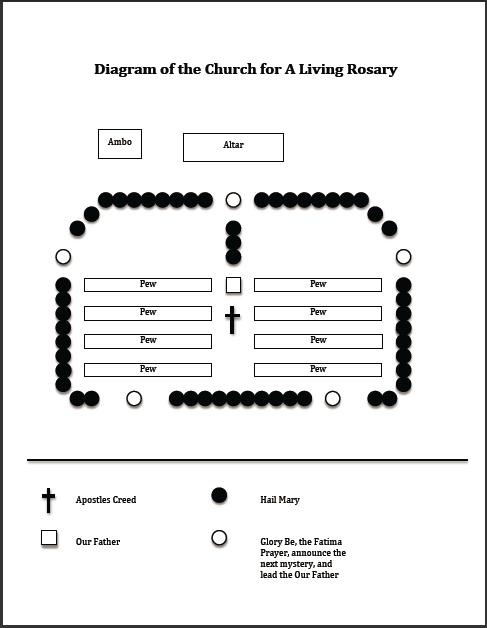Looking for a special way to pray the Rosary? Try bringing a Living Rosary to your school or religious education community. This beautiful prayer service takes some preparation and practice, but many teachers have found it makes for a powerful and prayerful annual tradition.
The Rosary, in this case, is made of students, with each representing a bead. Select a group of students (61 in all) to embody the Rosary in the church. Pass a wireless microphone, if available, around the human rosary, with each student leading the prayer associated with his or her position in the Rosary.
- Form the decades by arranging 50 students in segments of ten around the perimeter of the church. This can be a good way for younger students to participate, as they need only lead one Hail Mary each.
- Between the decades, place five individual students. This can be a good way for older students to take a leadership role in your community’s prayer, as each will lead the Glory Be, the Fatima Prayer, announce the next mystery, and lead the Our Father before passing the microphone to the next student.
- If your church has stairs leading up to the altar, this is a great place to form the “tail” of the rosary or you can bring the tail back into the middle of the church (see the diagram below). Have six additional students form a line from the main part of the “rosary” up toward the altar, bending the line slightly so students sitting in the pews can see. The student on the end should hold a crucifix, perhaps the one used during the opening and closing processions at Mass. As with the other groups, select students of an appropriate age to lead their corresponding prayers.
- Be sure to select a strong leader to offer the “Hail, Holy Queen” and “Sign of the Cross” at the conclusion of the Rosary. This will likely be the same leader who announces the first mystery and leads the first Our Father.

Select your group well ahead of time to allow for at least one rehearsal. You’ll want your “beads” to feel confident in their role as prayer leaders, and practice will help relieve the anxiety about where to stand, when to start speaking, and what to say.
On the day of the Living Rosary, gather your “beads” in the church and then bring in the rest of your students and have them sit in the pews. They may wish to bring regular rosary beads or may prefer to watch the microphone as it moves around the Living Rosary. Either way, this unique prayer service brings your whole community together around the Rosary.
Living Rosary Variations:
- If you plan to do a Living Rosary with a smaller number of children—a single class—then divide the students up into the different decades and “tail” of the rosary or have a Rosary procession very much like the Stations of the Cross only each “station” is a Mystery of the Rosary.
- If a cordless microphone is not available, you may want to select a small group of prayer leaders – perhaps one per decade and a sixth to begin and end the Rosary – and have them lead prayers from the ambo. In this case, you might give each “bead” a taper candle. As the prayer for their bead is said, the previous student can light that taper candle from his or her own. (This variation may be especially meaningful when praying the Luminous Mysteries!)
- Rather than simply announcing the Mysteries, you might have a group of older students prepare reflections on the mysteries to offer at the appropriate times.
- Invite guests from the community—parents, representatives of local social justice organizations, your pastor or resident sisters, etc.—to introduce the mysteries with reflections of their own. This can be a meaningful way to incorporate a focus on vocations into the Living Rosary.
You can download a PDF of the Diagram of the Living Rosary to use as a reference tool here:
This was a guest post by Jennifer Dees and Meghann Kirzeder who work for the Alliance for Catholic Education. They also wrote a popular collection of Catholic Schools Week Ideas that thousands of visitors found helpful in 2010.
Here are a few other ideas to help get your living rosary started with the kids:



Thank you for giving me an idea how I could organize a Living Rosary in our community tomorrow. See you in prayer.
Thank you for your guide and instructions for the Living Rosary for children. It was very helpful. God bless.
Hi, Jared! Thanks for your work. I wish to learn more about the origin of the Living Rosary. Do you know where, when or with whom it started? I am writing about it for a seminary class.
For any response you can offer, thanks.
Brother Paul Donnelly, CFR
St. Joseph Seminary, Dunwoodie, New York
Hi Brother Paul! I’ve never studied it to be honest. In fact, I’m not even sure where that kind of research would begin. It wouldn’t surprise me if parishes were doing it before schools. I’d love to hear anything you find.
You can do a internet search for ” living rosary”. There are several varations for the living rosary. I have been making rosaries out of 3/8 inch rope with knots for beads. You have to have a large group. Each person holds a knot and says the associated prayer (prayers) for that bead. There is also an association called living rosary and you commit to saying the rosary everyday, each person in his/her turn.
Hey Ross – Do you know anyone who sells the living rosary like you make? I am looking for one for an upcoming retreat. I’ve tried to make one, but have been unsuccessful.
Ross – Do you still make rosaries out of 3/8 inch rope? I’ve tried a couple of times, but have not been successful as of yet. I’d like to talk to you about it if you don’t mind. My email is joe.maire@yahoo.com.
I’ve taken part in a living rosary using a LARGE rope rosary. It’s a pretty powerful experience and I wanted to bring it to my parish.
I would be interested in the Origin of the Living Rosary. I am giving a presentation on the Rosary to the RCIA class in our parish. I am hoping to organize a living rosary but we have only about 20 max able to participate. Any suggestions.
Our school has a Living Rosary every October. Because we have such an ethnically diverse community, we have a multi-lingual Living Rosary. This has been a beautiful way to include the different languages that our students speak.
I organized, what I called a Living Rosary in my home parish in 2009, when my parish was slated to be closed and we needed some way of organizing a group Rosary prayer. I had help with several friends and recruited 61 people and found reflections on line to read for the mysteries. We had the lights off in the church except for the light on the Tabernacle, on the Crucifix and Blessed Virgin statue. Everyone had a candle, we lit the first candle from the Easter candle and then passed the flame to each person saying the prayers until the whole church was lit with candle light. Then each person in procession took up a single rose and placed the rose in a vase at the base of Our Ladies statue. It was absolutely beautiful. We have had 2 more Living Rosaries, and will have one this October 7th. It is well worth doing it in your parish.
I woud like to organize this living rosary in our parish. I want that every parokyanos being part of our
parish realize that prayer is very important in everyones life.
This information was extremely helpful to me in planning to do The Living Rosary this year with my SRE students. The power of prayer is so wonderful and it works.
Interesting to be receiving this today. We are planning a Living Rosary tomorrow evening with the involvement of our three parishes, parochial school children, CCD children, various ministries. Your diagram is a welcome addition to our planning as well! Plus, I hope to “set the table” by reading a section from Diane Moczar’s “Ten Dates Every Catholic Should Know” regarding the battle of Lepanto and our Lady’s part in that victory.
Thanks for your good work, Jared. God bless you and those who work with and support your apostolate.
I was first part of a living rosary in 1999 when I moved to a rural area that had the longstanding tradition of a family night the first Wednesday of Advent. They prayed the Living Rosary with families from 4 small towns and 2 parishes in the gathering hall. They arranged chairs similar to the diagram above, but weren’t restricted by the pews. As a family activity, parents were encouraged to sit next to students who might be too small to lead on their own, but nothing is cuter than a three-year-old saying something like “Hail Mary” and everyone else joining in to complete the prayer. We did some variations every year. High school students often introduced the mystery, sometimes posed as a statue in the middles, once did shadows behind a screen at the far end of the room to illustrate each mystery (loved the prep time discussing the mysteries and having them write meditations that I’d edit if needed). We did candles like the one commentator mentioned, passed a rose one time, had a “marker” carrying a candle stand by the spot in the rosary that we were at or none of that and just spoke as we could. This year we’ve invited all families and older people in our parishes to bring a rosary that is meaningful to them and share with the group why (we’ll do that via interviews with the high school students – some being videoed and if good and they approve, might be incorporated into the elementary Christmas program in Dec.) The living rosary is a great skeleton for powerful prayer experiences in a parish.
Amazing tribute to God. Great work. God grant you a place in heaven. Amen